Intelligent path control for energy-saving in hybrid SDN networks
Abstract: As power consumption of the internet has been growing quickly in recent years, saving energy has be- come an important problem of networking research. Software-Defined Networking (SDN) brings excellent opportunities to improve network performance and reduce energy consumption by flexible centralized control. However, due to budget constraints and technique limitations, ISPs can upgrade only a limited number of conventional switches in backbone networks to SDN devices at one time. In this paper, we propose one heuristic scheme for incrementally deploy SDN switches in hybrid SDNs, the objective of which is to achieve energy saving by rerouting the flows to shut down idle links and switches as many as possible. Our solution can achieve two objectives: 1) maximizing the network control ability with a given SDN switches upgrading budget constraint, and 2) maximizing energy saving by shutting down idle links and switches with deployed SDN switches. The results of evaluations show that our scheme can achieve 95% of the number of flows controlled with only 10% of upgrading cost, and it also can achieve saving more about 10% of the total power consumption when compared to the existing solutions.
Key words: Software-Defined Networking, Switch deployment, Energy saving, Network management.
1 Introduction
Software-Defined Networking (SDN) technique is widely used in recent years, and it separates the network control plane from the packet forwarding plane and provides applications with an ab- stracted centralized view of the distributed network state [1]. Mi- crosoft, Google, Amazon and other companies deploy their SDNs and obtain a lot of benefits [2]. At the same time, energy con- sumption from the data centers and ISP networks is increasing fast. With the expansion of network scale, energy consumption is even demonstrated to surpass the equipment cost. The work [3] points out that the ratio of Internet energy consumption accounts for up to 10% of the worldwide energy consumption. Therefore, energy saving is important not only for economical and environmental reasons, but also for the sustainable growth of Internet, due to the challenges imposed by power delivery to and heat removal from giant data centers [4,5]. Besides, SDN switches cannot be deployed at one time due to the funding and technical constraints. So it is a good method to solve the issue of energy saving using the incre- mental deployment of SDN switches.
Generally speaking, the network upgrade is a complex opera- tion. ISPs consider not only the budget constraints but also the normal network operation [6,7]. Thus, it is not practical to up- grade all network devices (e.g., switches and routers) in networks to SDN devices at one time. In the existing work [1,8–10], the au- thors state that the SDN switches and the current Internet can co- exist with each other, and the SDN networks can be incrementally deployed to the Internet. Therefore, ISPs should trade off finan- cial consideration and the network control ability (NCA) to deploy1 SDN switches in existing networks [11]. The hybrid SDNs, which are composed of SDN devices and traditional network equipment, will coexist during a long time [12]. Network operators must be able to incrementally deploy SDN switches in order to control and manage the network more flexibly.
Energy consumed by network devices such as switches is not in proportion to the utilization of its links, which means energy consumption is high compared to the amount of carried traffic in the network. On the whole, energy efficiency of the Internet is very low [13,14]. Generally speaking, turning on a switch consumes most of its power, and getting the utilization of a link from idle to full only consumes an extra 8 percent of power [15]. Although all the nodes are active all the time, it is shown that at most 40% percent of the capacities of links are used [16]. Therefore, we can turn off links and switches that are unnecessary in the network to save energy. Having a global network view, the SDN controller is able to determine the power sates and routing decisions in the net- work. Moreover, the SDN controller can install flow table entries on switches to encapsulate Multi-Protocol Label Switching (MPLS) la- bels for each packet to indicate the routing information of forward- ing path. We can achieve the purpose of energy saving by precisely controlling the forwarding path of each flow using SDN controller. Moreover, under the constraints of capital and manpower, the de- ployment of SDN requires an extended period. So we can solve the issue of energy saving using the incremental deployment of SDN switches.
* Corresponding author.
E-mail addresses: jxy14@mails.tsinghua.edu.cn (X. Jia),
jiangy@sz.tsinghua.edu.cn, 1079596796@qq.com, jiangy@mails.tsinghua.edu.cn (Y. Jiang), sgb16@mails.tsinghua.edu.cn (G. Shen).
Our objective is to minimize network energy consumption by deploying SDN switches under the budget constraint. To achieve the efficient energy saving, we are faced with two challenges: 1) given a limited number of SDN switches, how to incrementally de- ploy them to achieve the maximum NCA improvement. 2) Fixed SDN switches deployment location, how to maximize energy sav- ings by rerouting the flows. Because of the distributed control in traditional networks, it is difficult to coordinate between devices. But in SDN networks the SDN controller can precisely control the flow path by encapsulating MPLS labels to packets. In this way, we propose the Exact Path Control (EPC), which is the flow-level explicit path control scheme to turn off links and switches that are unnecessary in the network to save energy. Moreover, the ad- vantage of the flexible segment routing among SDN switches con- tributes to the energy saving. The main contributions of our work can be summarized as follows:
1) We formulate an optimization problem to achieve the max- imum NCA with little upgrading cost. We prove that the problem is NP-hard, and give a heuristic algorithm to solve it with low complexity. Our scheme can achieve the minimum number of SDN switches to achieve the maximum NCA im- provement in a network [17,18].
2) We formulate the question that maximize energy saving with the fixed position of SDN switches deployed. We analyze the complexity of the question. Based on the deployment of SDN switches, we propose EPC to save more energy than other schemes by rerouting the flows.
3) The results of the evaluation show that our scheme can achieve 95% of the number of flows controlled with only 10% upgrading cost, and it also can achieve saving about 10% of the total power consumption when compared to the existing solutions.
The rest of the paper is organized as follows. In Section 2, we discuss some related works. In Section 3, we illustrate the motiva- tion and overview of the paper. Section 4 describes the issue and formulates it as an optimization issue. In Section 5, we prove that the problems are NP-hard, and also present a heuristic scheme to solve the questions. In Section 6, by comparing with the previous algorithms, our scheme can achieve better performance with few footprints. Section 7 concludes the paper.
2 Related Works
Some existing works propose deploying SDN switches to achieve network security, load balancing and traffic scheduling [9,19,20]. Dan Levin et al. [21] deploy SDN switches in enterprise networks using VLANs and switch ports to enable each flow to go through at least one SDN switch. The scheme is limited by the number of VLANs, and has a long path stretch. In [1], the objec- tive of the authors is to develop a SDN deployment scheme that can dynamically manage traffic in a network to accommodate dif- ferent traffic patterns. The solution has high complexity and is not feasible to use in backbone networks. Chu et al. [9] propose an approach to guarantee traffic reachability in the presence of any single link failure. By redirecting traffic on the failed link to SDN switches through pre-configured IP tunnels, the proposed approach can react quickly to the failures. With the help of coordination among SDN switches, it is able to explore multiple backup paths for traffic recovery. However, it increases the controller burden for complex pre-computed and wastes the flow table entries for pre- configured.
There have been a number of works focused on saving energy in traditional networks. The energy saving issues of OSPF protocol is studied in [13], where a novel network-level strategy is proposed to save energy based on a modification of current link-state rout- ing protocols, such as OSPF; according to this strategy, IP routers are able to power off some network links during low traffic pe- riods. But the solution in [13] is only a subset of router Shortest Path Trees (SPTs) that used to select the routing paths. In [4], the IP routers perform the shortest path routing using the distribute OSPF link weight optimization. While the SDN switches perform the multi-path routing with traffic flow splitting by the global SDN controller. They propose the scheme HEATE witch finds the opti- mal setting of OSPF link weight and splitting ratio of SDNs. Thus the traffic flow is aggregated onto partial links and the under uti- lized links can be turned off to save energy. Because [14] describe that after deciding on the values of the weights, a human opera- tor needs to change the IGP configuration on one or more routers, moreover, the scheme HEATE is based on [14] to develop the sys- tem. Thus, HEATE cannot run in the backbone environment.
In [3], the authors propose an energy-aware routing and re- source management model for large-scale networks based on SDN switches deployment. The controller of witch uses pre-established multi-paths (PMPs) and perform routing, admission control based on these paths. PMPs are turned on or off based on traffic conditions to save energy. However, they routing the flows by predefined fixed path that only connect ingress (IRs) with egress routers (ERs). So this path-based energy saving program is not flexible enough. In [22], Semu Tadesse et al. propose an effective way to achieve such a goal is to act on the backhaul network by control- ling the nodes operational state and the allocation of traffic flows. Their scheme, named EMMA, aims to both turn off idle nodes and concentrate traffic on the smallest possible set of links, which in its turn increases the number of idle nodes. In [23], B. Rawat et al. present various security threats that are resolved by SDN and new threats that arise as a result of SDN implementation. They also pro- vide a survey on the different strategies that are implemented to achieve energy efficiency and network security through SDN implementation.
In [24], the authors focus on the hybrid SDN network scenario and discuss about the migration algorithms from the perspective of traffic engineering in an ISP network. It mainly concentrates on searching for an optimized migration sequence of the routers in the traditional IP network to minimize the maximum link utilization. But it does not give a specific SDN switch deployment plan and needs to set the switch ports. We deploy the minimum number of SDN switches within budget and achieve almost all of the flows go through at least one SDN switch. In [11], Chu et al. summarize different types of hybrid SDN networks including topology- based, service-based and class-based hybrid SDN networks. They show a number of use cases in which hybrid models can mitigate the respective limitations of traditional and SDN approaches, pro- viding incentives to (partially) transition to SDN. We propose the flow-based scheme that can control almost all the flows by deploying only a small number of SDN switches.
The main idea in [25] is that the controller first chooses the set of routes that minimizes the number of used network equipments for the current traffic, and then they put SDN nodes in sleep mode by putting them in power save mode which also turns off net- work interfaces. The authors consider a typical dynamic traffic of an operator and adapt the numbers of active and inactive network equipments during the day. They reused the idea in [9] to reroute the flows from any node, with a turned off link, to any other node with a direct path towards the destination which does not include a disabled link. The goal is to avoid waiting for the convergence of legacy routing protocols by using tunnels from a node with a failing link to an SDN node which can reach an alternative OSPF shortest path in one hop. Thus, their scheme need to pre-configure the switch in advance, and also need to set a large number of tun- nels. The authors in [15] consider to find minimum-power network subsets in partially deployed SDNs. The objective of this paper is to develop a scheme that is able to dynamically adjust the active network subsets in the partially deployed SDN to satisfy changing traffic loads, as well as to reduce unnecessary energy consumption. The controller is responsible for all the SDN elements power states, but those non-SDN elements power states cannot be operated by the controller. Therefore, the basic idea of their solution is to shut down as many SDN elements as possible, in the condition that the alive network subset can satisfy the traffic demand, so that they can reduce unnecessary energy consumption. But the power states of non-SDN elements cannot be operated by the controller, the total saving energy in the network only include the power consumption of the SDN elements that can be shutdown.
3 Motivation and Overview
Throughout this paper, we try to solve the challenge of how to incrementally deploy SDNs to achieve energy saving. To achieve the efficient energy saving, we are faced with two questions: 1) given a limited number of SDN switches, how to place them to achieve the maximum NCA improvement? 2) Fixed SDN switches deployment location, how to maximize energy savings by rerouting the flows. We first deploy SDN switches to allow almost all of the flows to go through at least one SDN switch. Then we design the EPC algorithm to achieve energy savings by turning off the idle links and switches.
The latest OpenFlow protocol supports MPLS technology [26], and the Push MPLS header actions can push new MPLS headers onto the packet. The controller can install flow table entries on SDN switches to encapsulate MPLS labels for each packet to indicate the routing information of forwarding path. Therefore, we can achieve accurate path control for each flow by encapsulating MPLS in networks. We propose an energy-aware rerouting model for hybrid SDN networks based on MPLS labels. The key is that we can flexibly change the forwarding path of the flows by encapsulating MPLS tags to indicate the forwarding information, and then we shutdown idle links and switches to achieve energy saving. Moreover, we can aggregate the flow table entries based on the segmented routing between SDN switches. Next we show how to deploy SDN switches and how to precisely control the flow path to achieve energy savings in detail.
3.1 Incrementally deploy SDN switches
We cannot deploy SDN switches for the entire network at one- time limited by resource constraint. The key is how to deploy limited SDN switches to achieve maximum NCA improvement. We assume the NCA is the flows that can be flexibly managed by deploying SDN switches in the network [27]. Through investigation we find that there exist key nodes in the WAN and date center that most of the traffic pass through them [9,19]. We can incrementally upgrade the least key nodes that all the flows must go through to improve NCA. The upgrading cost of a network is the total cost for upgrading conventional switches to SDN switches in the network. For switch vi, its cost depends on many factors, such as ni, the number of forwarding ports in the node, and si, the traffic processing speed in the node [28]. For example in Fig. 1, the SDN switch S1, S2, are the key nodes that all the flows of source- destination pairs must pass through them. We propose the Greedy upgrading algorithm to incrementally deploy SDN switches to improve the NCA. After deploying the SDN switches, the SDN controller collects network information and reroutes the flows to optimize the energy saving in the networks.
3.2 Explicit path control to achieve energy saving
In our scheme, the SDN switches rerouting packets based on multiple MPLS labels which take the forwarding ports of switches. The latest OpenFlow protocol supports MPLS technology [26], the Push MPLS header actions can push new MPLS headers onto the packet. When a new MPLS tag is pushed on an IP packet, it is the outermost MPLS tag, inserted as a shim header immediately before any MPLS tags or immediately before the IP header. SDN switches encapsulate multiple MPLS labels for each packet that indicates the forwarding port numbers of switches on its route. Energy saving requires fine-grained flow scheduling to shutdown switches and links. SDN switch achieves fine-grained flow scheduling by encapsulating the MPLS labels to take the forwarding information. Thus, it can save energy by rerouting the flows to turn off the idle links and switches.
For example, Fig. 2 shows an example of using MPLS labels to achieve energy saving in the network. We assume that there are only two flows in the topology, which are f1 from h1 to h3 and f2 from h2 to h3. The path of the flow f1 is {h1, s1, s2, s3, s4, s7, h3}, while the path of the flow f2 is {h2, s5, s6, s7, h3}. The controller selects switch s2 to install flow entries to reroute the flow f1. When the packets of flow f1 enter the SDN switch s2, they are encapsulated with 3 MPLS labels, {2,2,2}, each number indicates a forwarding port of the switch on its route. The packets pop up one MPLS label as a forwarding port of switch when they pass through the switch. The new path of the flow f1 is {h1, s1, s2, s5, s6, s7, h3}. Thus, we can achieve energy saving by turning off the switches s3, s4 and the links s2 → s3, s3 → s4, and s4 → s7. Moreover, unlike traditional network MPLS, there is no need to maintain path state in forwarding path exc
Fig. 2. An example of using MPLS label to achieve energy saving in the network. The controller configures the rerouting path for the flow h1→h3 by installing the flow entries at switches s2.
ept on the ingress node, because packets are now routed based on the list of labels they carry [29].
3.3 Flow table aggregation by segment routing
The papers [7,30] propose the segment routing architecture and they detail the operation mechanism of segment routing in wide area networks and data centers. Segment routing also enables finer control of the routing paths and can be used to route traffic through middle boxes. We break up the routing path into segments in order to reduce the flow table entries and improve the flexibility of rerouting. While implementing energy savings, we can aggregate the flow table entries based on the segmented routing between SDN switches. Therefore, we introduce the flow sets to path aggregation and path ID assignment methods based on the coincidence degree of flows on the forwarding paths.
We reused the flow entries by encapsulating the MPLS labels for the flows of those forwarding paths are overlap. Moreover, we also reused the flow entries to pop up the MPLS labels to indicate the switch port number of the forwarding path for the flows. For example, in Fig. 2 we can install a flow table entry at switch s5 to encapsulate MPLS labels for both flow f1 and flow f2 to indicate the forward information.
4 Problem Formulation
The goal of our issue is to achieve energy saving by incremen- tally deploying SDN switches. Firstly, we maximize the NCA with a given SDN switches upgrading budget constraint. Secondly, we maximize energy saving by shutting down idle links and switches with deployed SDN switches. We assume that the SDN forwarding elements are a subset of the nodes in the network. The rest of the nodes in the network run some standard hop-by-hop routing pro- tocol like OSPF [1,31]. Using the information collected by each SDN switch, the SDN controller is able to peer the entire network and be aware of the workload on each link as well as the traffic vol- ume between different source-destination pairs [9]. Then, we can achieve energy saving by flexibly scheduling the flows to turn off links and switches.
We formulate a network as a graph G= (V,E ), where V is the set of nodes, and E is the set of links. Let F denote the set of traffic flows. We use v_i to represent a node in the network, l_{ij} to represent the link between nodes v_i and v_j. Let C_{ij} denote the capacity of link l_{ij}, andf^k_{ij} (f^k_{ij}\in \mathcal{F}) be the size of the k-th flow on link l_{ij}. Let the source and destination nodes of flow f^k_{ij} be s^k and d^k. We use F_{v_i} to denote the set of flows passing through node v_i. The notations for this paper are listed in Table 1.

4.1 Deploying SDN switch to holding more flows
Typically, the NCA of a network is associated with the number of controlled flows in the network. The SDN switch can flexibly control the flows in the networks. Then we improve the NCA by in- crementally deploying SDN switches. In [9], the authors show that the hybrid SDN network can achieve fast recovery and guarantee reachability from any single link failure if the flows pass through at least one designated SDN switch. In [21,32], the authors show that it becomes possible to operate the most of an enterprise net- work for every source-destination path that includes at least one SDN switch. Therefore, the links and switches can be turn off by flexibly rerouting the flows if they traverse at least one SDN switch in hybrid networks. To quantify the performance of a network, we introduce some definitions below:
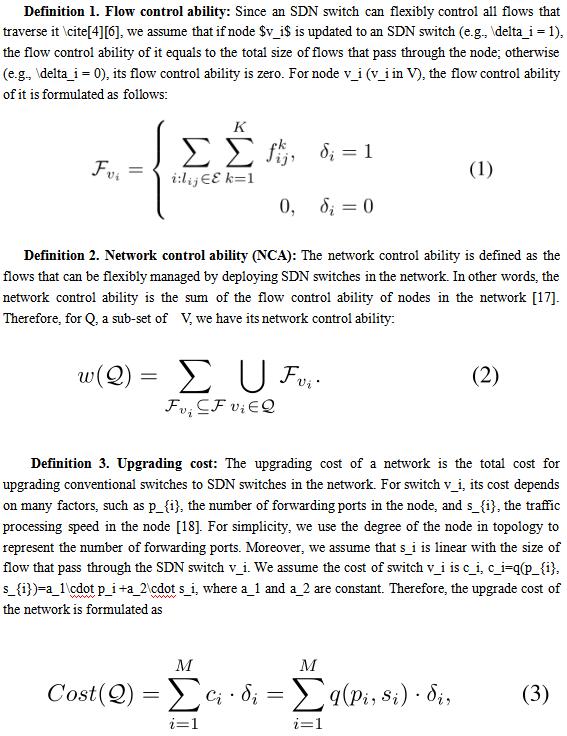
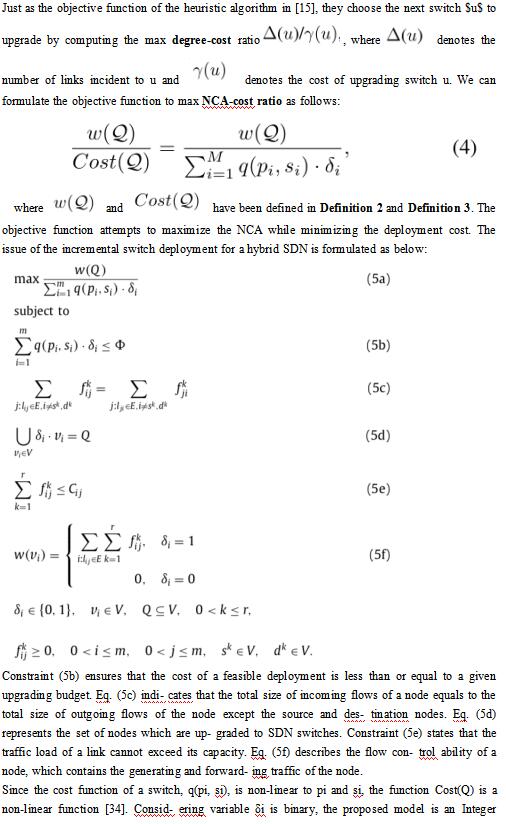
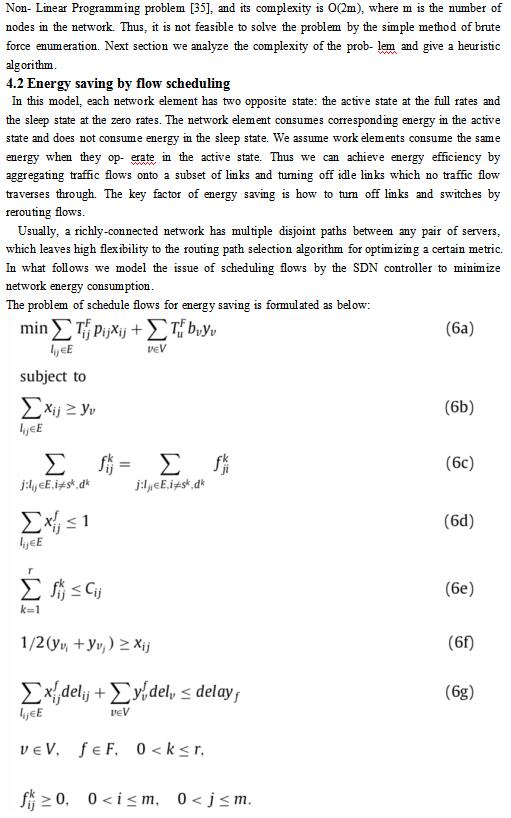

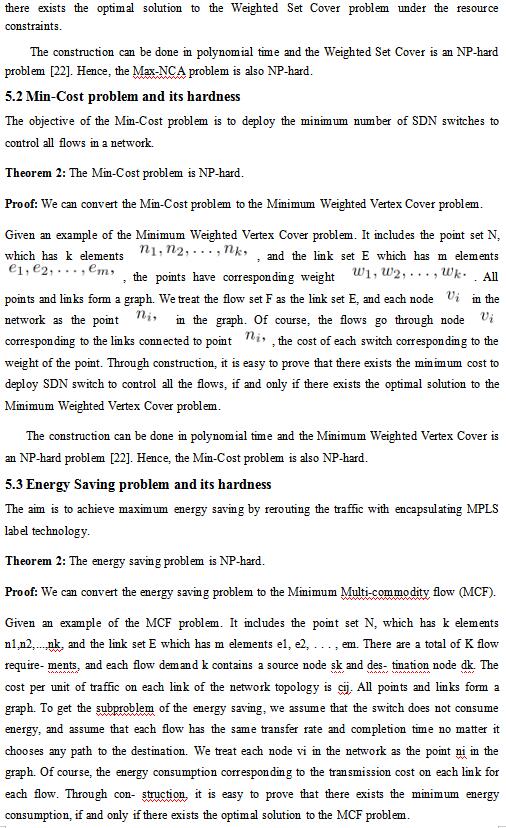
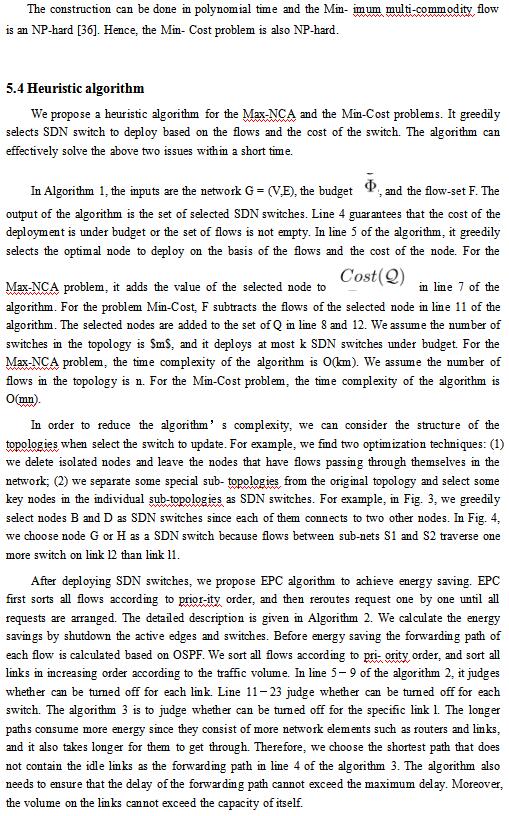


6 Simulation
In this section, we evaluate our solution against the baseline scheme in network topologies. The simulation results of the fol- lowing algorithms are compared with each other to evaluate the Algorithm 1. The Heuristic scheme is use Algorithm 1 to update nodes to SDN switches. The scheme Degree-first in [32] is to choose the switch v that has the maximum number of links incident to it- self, and then upgrade the switch. The scheme Random randomly selects nodes to upgrade to SDN switches in the network. In order to verify the effect of energy saving by the Algorithms 2 and 3, we compare the scheme EPC to the scheme PLSP [3] and the scheme EA-FA [4].
6.1 Simulation setup
In our simulation, we use two network topologies the ISP 1755 and the ISP 3967 from the Rocketfuel [37,38]. In networks, there may be no communication between some node pairs. Thus, we consider two cases. In Case 1, each node transmits flows to all other nodes, while in Case 2, only a part of node pairs communi- cate with each other. We can get network topologies and infer the link weights of each edge form Rocketfuel [38]. The traffic matrix is the data set obtained from the TOTEM [39] project and obtained by S. Uhlig [40].
6.2 The flows that can be controlled
We propose the Algorithm 1 to solve the problem that incre- mental deployment SDN switches in hybrid networks. Since the flows between node pairs are dynamically generated, and the size of each flow is also dynamic, we use the average control flow num- ber as the experimental parameter [41]. We use σ to indicate the percentage of the controlled flows.
6.2.1. Case 1: flows between all nodes.
Fig. 5 shows the results of the problem Max-NCA in ISP 1755 and ISP 3967. Among the three schemes, Random performs the worst. In Fig. 5(a), Random requires 14% cost to improve 55% of σ, while Heuristic needs only 2% cost. Heuristic needs only 10% cost to realize 98% of σ improvement. The advantage of the heuris- tic is obviously better than the Degree-first when the percentage of upgrading cost is less than 8% in Fig. 5(a) or less than 14% in Fig. 5(b). The performance of the heuristic algorithm is best be- cause it first chooses the core node with maximum flow to up- date. Seen from Fig. 5(b), the results of Heuristic also outperform Random and Degree-first. Comparing Fig. 5(a) with Fig. 5(b), we can conclude that with the extending of the network scale, Heuristic’s advantage is more apparent than Random and Degree-first.
6.2.2. Case 2: flows between certain node pairs.
We compare these results in two instances that 1/3 node pairs have flows to transmit in Fig. 6, and 2/3 node pairs have flows to transmit in Fig. 7. For the two cases, we randomly generate node pairs 100 times and ran our algorithms 100 times to get the average value on a high-performance computer. In networks, the flows are dynamically generated, so the average value of 100 ex- periments is realistic and persuasive.
From Fig. 6, we can see the minimum percentage of SDN switch cost when fixed the proportion of the control flows. The Fig. 6 shows that, when we want to control 95% of the num- ber of flows, we need to upgrade only about 6% of the nodes to SDN switches. Similar to the results of Fig. 5, the Heuristic algo- rithm in Fig. 6 also outperform Degree-first algorithm and Random algorithm. Compared Fig. 6 to Fig. 7, the Heuristic algorithm can achieve good results whether 1/3 node pairs have flows or 2/3 node pairs have flows. In addition, the Fig. 6 and Fig. 7 show that the results of the algorithms are similar even in different topolo- gies. Moreover, the Heuristic is always better than Degree-first and Random in any case. Therefore, our algorithms are universal and extensive.
Since following the heavy-tailed distribution, the percentage of upgrading cost is relatively large when σ is equal to 100%.
6.3 Energy saving ratio using the scheme EPC.
We evaluate our solution EPC against the baseline schemes PLSP and EA-FA in network topologies. PLSP assumes that PLSPs are pre- defined, and ingress (IRs) and egress routers (ERs) are connected with each other by PLSPs. Active paths carry network traffic from IRs to ERs and passive paths stay in sleep mode. If controller wants to use them, it actives them by turning on network elements along the path. The main idea of Pre-established Label Switching Paths PLSP is move the traffic to a fewer number of paths. After adjust- ing the users’ traffic to reasonable paths, it put idle links and line- cards to sleep.
The scheme EA-FA [4] achieves energy efficiency only by per- forms optimizing traffic splitting ratio in SDN-enabled switches. In [4], they also put forward the scheme HEATE, but HEATE cannot be implemented in the networks. Because after deciding on the values of the weights, the scheme HEATE needs an automated system or a human operator to change the IGP configuration on one or more routers [14]. Fig. 8show energy saving ratio increasing with the de- ployment of SDNs for ISP 1755 and ISP 3967 network, respectively. The definition of energy saving ratio in our study is the ratio of formula (6a) computed by proposed scheme to which computed by traditional OSPF protocol. From Fig. 8, we can see that energy saving ratio of all schemes increase rapidly with the increase of deployed SDN-enabled switches in the network. The reason is that with the increase of SDNs, the central SDN controller can control more traffic flows and globally choose the optimal path for them to maximize energy saving. When the number of deployment SDNs is greater than a threshold, the variation of energy saving ratio be- comes relatively flat. This is because when the deployment of SDNs reaches a threshold, an approximately optimal energy saving flow allocation can be achieved. More SDN-enabled switches deployed into the network will make no obvious enhancement in energy saving. As we can see from the Fig. 8, the energy saving perfor- mance of the EPC always outperforms PLSP and EA-FA. Since EA-FA achieves energy efficiency only by performs traffic splitting ratio in SDN-enabled switches, the energy saving ratio is less than the scheme of PLSP when the number of SDN switches deployment is small. PLSP routing the flows by predefined fixed path that only connect ingress (IRs) with egress routers (ERs). Therefore, with the increasing of SDNs deployment, the energy saving ratio of EA-FA is large than PLSP. Seen from the whole view, EPC can save about 10% of the total power consumption on average when compared to the other solutions.
In this group of simulations, we adjust traffic load by chang- ing the number of flows in the network. As result shown in Fig. 9, with the increase of the traffic load in the network, energy saving ratio of all the algorithms are decrease. This is because larger traf- fic loads means that the forwarding needs more network elements. Thus, elements that can be closed become less. For all the volume of the traffic load, our scheme EPC is better than the other two scheme. When the flow is small, the difference between the differ- ent schemes is relatively large. Large traffic requires more network devices, so the number of links and switches that can be turned off is relatively small. Therefore, the gap of energy saving ratio is relatively small when the traffic load is large.
7 Conclusions and Further Work
In this paper, we propose one heuristic scheme for incremen- tally deploy SDN switches in hybrid SDNs, the objective of which is to achieve energy saving by rerouting the flows to shut down idle links and switches as many as possible. Taking into account the constraints, we propose two general questions: 1) given a lim- ited number of SDN switches, how to place them to achieve the maximum NCA improvement? 2) Fixed SDN switches deployment location, how to maximizing energy savings by rerouting the flows. The hardness of the two questions are proved. Then we propose the heuristic algorithms to solve them. The simulation shows that our scheme can achieve 95% of the number of flows controlled with only about 10% upgrading cost, and it also can achieve saving more about 10% of the total power consumption when compared to the existing solutions. In the next work, we will try to improve the quality of service (QoS) through packet classification or traffic engineering based on the controllable flows.
Acknowledgements
This research is supported in part by the 973 Program of China (No. 2012CB315803), the National Natural Science Foundation of China (No. 61402255), and the Research Fund for the Doctoral Pro- gram of Higher Education of China (No. JSGG20150512162853495, No.Shenfagai[2015]986, and JCYJ20150630170146830). The research is also supported by the National Natural Science Foundation of China under Grant 61625203, the National Key R and D Program of China under Grant 2016YFC0901605, the R and D Program of Shenzhen under Grant JCYJ20170307153157440 and JCYJ20160531174259309.
分享让更多人看到 
推荐阅读
相关新闻
- 评论
- 关注



























 第一时间为您推送权威资讯
第一时间为您推送权威资讯
 报道全球 传播中国
报道全球 传播中国
 关注人民网,传播正能量
关注人民网,传播正能量